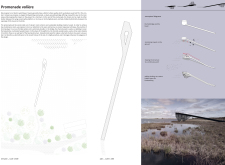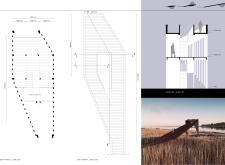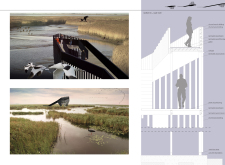5 key facts about this project
At its core, the project functions as a birdwatching promenade that invites visitors to engage with the rich biodiversity of the area. The design facilitates observation and appreciation of wildlife, providing a unique vantage point that encourages both relaxation and exploration. The gentle ascent of the promenade allows visitors to engage with the landscape from various heights, enhancing their connection to the environment.
The architectural design reflects a commitment to sustainability, employing local materials that not only reduce the carbon footprint but also resonate with the cultural context of the region. Key materials used in the construction include charred wood, laminated timber, plank wood flooring, as well as a robust steel base plate and concrete foundation. Each material serves a distinct purpose while contributing to the overall aesthetic and structural integrity of the project. The use of charred wood not only showcases durability and resistance to weathering but also introduces an elegant texture to the façade, blending the building into the natural landscape rather than imposing upon it.
Important elements of the project include hidden niches designed specifically for birdwatching, which allow for unobtrusive observation of wildlife. These shaded lookouts enable visitors to engage with their environment without disturbing the local fauna. This innovative approach showcases a unique understanding of how architecture can serve the purpose of conservation while enhancing public interaction with nature. The cantilevered sections of the promenade further exemplify a design that prioritizes visual appeal and experience, offering uninterrupted views and a fluid connection to the surroundings.
The integration of natural landscaping into the site plan is another significant aspect of the project. By allowing native vegetation to thrive beneath and around the structure, the promenade becomes a part of the ecological system rather than an isolated entity. This design approach not only promotes biodiversity but also fosters a sense of continuity between built and natural environments.
The architectural design embodies a philosophy that sees architecture not merely as a practical structure but as a facilitator of experiences that connect people with their environment. The promenade serves as a model for future projects that aspire to create spaces where nature and human activity can coexist harmoniously. The careful consideration of design elements—ranging from the choice of materials to the details of the promenade's form—demonstrates how thoughtful architecture can promote conservation and appreciation of the natural world.
For those interested in further exploring this project, reviewing the accompanying architectural plans, architectural sections, and architectural designs will provide deeper insights into the innovative ideas and functional aspects integrated into the Promenade Volière. Engaging with these materials will enhance understanding of how this project not only represents a significant architectural achievement but also a commitment to preserving and celebrating the beauty of the natural environment.


























